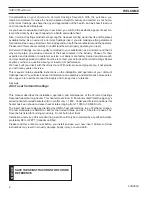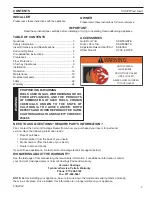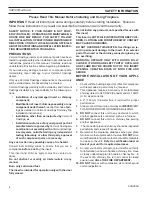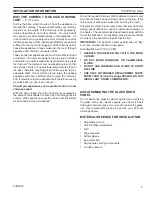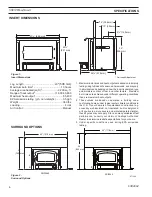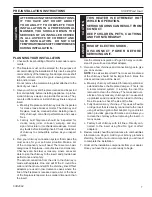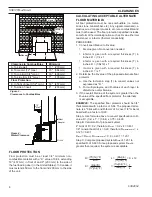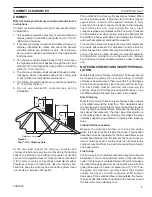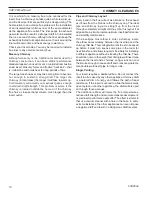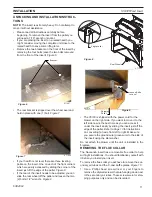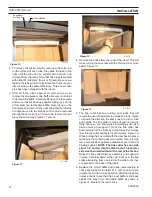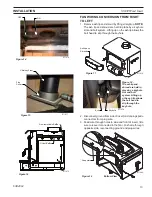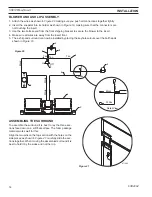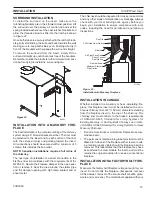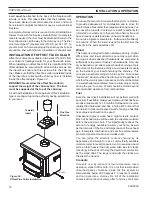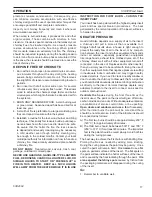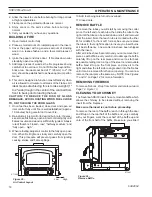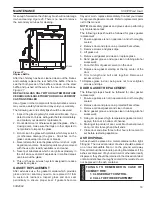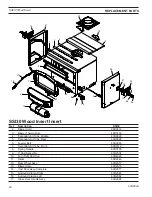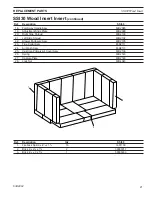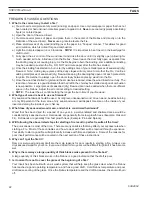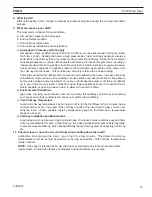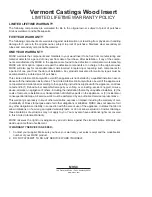
SSI30 Wood Insert
16
63D4004
INSTAllATION & OpERATION
insert
must
be attached to the back of the fireplace with
screws or nails. This label states that the fireplace may
have been altered to accommodate the insert, and must
be returned to original condition for use as a conventional
fireplace.
A complete chimney reline is required in most installations.
Always check with the fireplace manufacturer. If a complete
reline is required, the liner must be attached directly to the
flue collar and run all the way to the chimney cap. The liner
must meet type HT requirements (2100
°
F) per UL 1777. To
prevent room air from escaping up the chimney cavity, seal
around the liner with high temp insulation or sheet metal.
INSTAllATION OF OFFSET FluE COllAR
Offset flue collars are available in two sizes (3" and 6") from
your Vermont Castings dealer for your Savannah insert.
When installing an offset flue collar it is important that the
offset adapter be secured with at least three screws into
the insert flue collar and three screws into the chimney
liner. Make sure that the offset flue collar is installed inside
of the insert flue collar and the chimney liner is installed
inside the offset adapter.
Figure 24
WARNINg: Never allow the offset flue collar to
support the weight of the chimney liner. The liner
must be supported at the top of the chimney.
As with all installations, final approval of this installation
type is contingent upon the authority having jurisdiction
in your area.
ST1085
offset flue collar
Towards
Insert
Flue gas
direction
ST1085
Figure 24 -
Offset Flue Collar Installation
OpERATION
To reduce the amount of creosote that may form, remember
to provide adequate air for combustion and to strive for
small, intense fires rather than large smoldering ones. You
can never be too safe. Contact your local fire authority for
information on what to do in the event of a chimney fire, and
have a clearly understood plan on how to handle one.
Do not use a grate or elevate fire. Build wood fire directly
on firebrick. When the insert is used for the first time the
solvents in the paint will smoke off.
Wood
This heater is designed to burn natural wood only. Higher
efficiencies and lower emissions generally result when
burning air dried seasoned hardwoods, as compared to
softwoods or to green or freshly cut hardwoods. Only use
dry seasoned wood. Green wood, besides burning at only
60 percent of the fuel value of dry wood, deposits creosote
on the inside of your insert and along the chimney. This
can cause an extreme danger of chimney fire. To be called
“seasoned,” wood must be dried for a year. Regardless of
whether the wood is green or seasoned, it should be stored
in a well-sheltered ventilated area to allow proper drying
during the year to come. Wood should be stored beyond
recommended clearance from combustibles.
Fuel
Even the best insert installation will not perform well with
poor fuel. If available, always use hardwood that has been
air-dried (seasoned) 12-18 months. Softwood burns more
rapidly than hardwood and has a high pitch content that
can result in creosote. Decayed wood of any type has little
heat value and should not be used.
Unseasoned (green) wood has a high moisture content.
Much of its heat value will be used to evaporate moisture
before the wood can burn. This significantly reduces the
amount of energy available to warm your home, as well
as the intensity of the fire and temperature of the exhaust
gas. Incomplete combustion and cool flue temperatures
promote creosote formation and weak draft.
You can judge the moisture content of wood by its
appearance and weight or use a commercially available
moisture meter for exact measurement. Unseasoned wood
will be a third heavier than dry wood. Also look for cracks
(checking) in the ends of the log that result from contraction
as the wood dries. The longer and wider the cracks are,
the dryer the wood is.
Creosote
Creosote is a by-product of low-temperature insert
operation, weak draft or both. It is a tar that results when
unburned gases condense inside the flue system at
temperatures below 290 degrees F. Creosote is volatile
and can generate a chimney fire. All of the installation
characteristics that adversely affect chimney draft also

